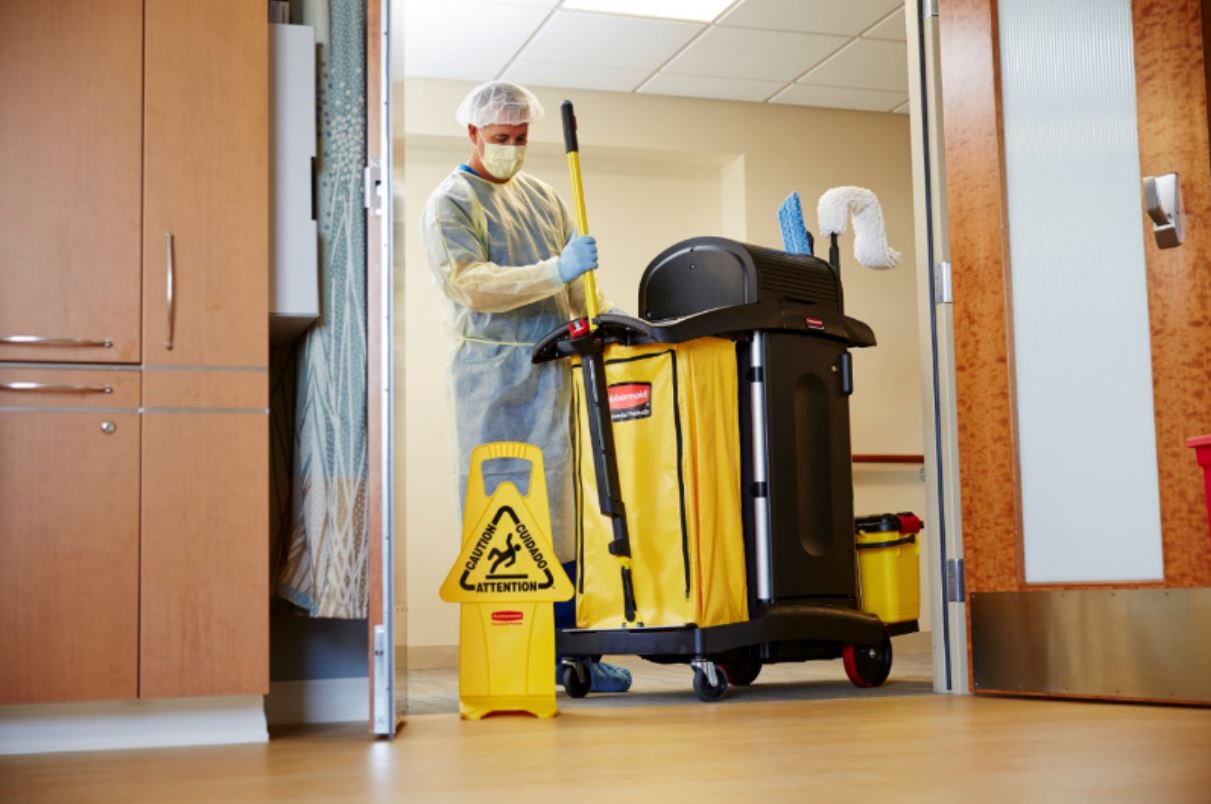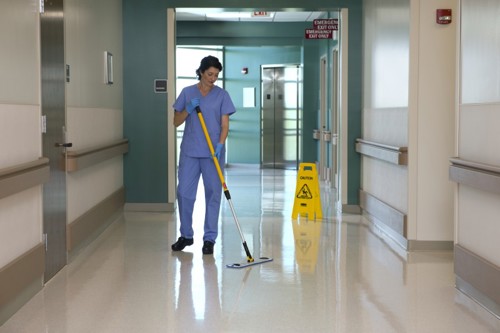
Water in a mop bucket can quickly become dirty, reducing the effectiveness of the mop and spreading contaminants. This is especially important to be aware of in healthcare and hospitality settings where maintaining cleanliness is crucial. This article provides practical tips on keeping your mop clean, including how often to change dirty mop water, best practices for cleaning different types of mops and proper storage techniques.
We also discuss the benefits of dry mopping, the use of microfibre mops in hospitals and how to handle biohazard spills effectively. By following these guidelines, custodians can ensure cleaner floors, improve infection control and maintain a healthier environment.
How Often To Change Dirty Mop Water
Mopping trollies with a dual bucket and wringer system can keep mop water cleaner and safer for longer, but they still require frequent changes. When using this type of system, the dirty mop should be returned to the rinse water and then wrung out before placing it back into the cleaning solution. Custodians should ensure that all debris and sedimentation are removed from the mop head before placing it into the cleaning solution. Regularly changing the mop water ensures cleaner floors and enhances infection control, particularly in healthcare settings.
When the cleaning solution becomes visibly dirty, it's time to rinse out the buckets, change the mop head and start with fresh cleaning solution. There's no standard regulation concerning the frequency with which mop heads or water should be changed, so custodians should use their best judgment. Using clean water and following these cleaning tips can help maintain hygiene and prevent the spreading of contaminants.
Putting dirty water back onto the floor not only defeats the purpose of cleaning, but it can also put people at risk, especially in healthcare environments. Hospital custodians should change their mop water after cleaning a patient's room, particularly if the patient is experiencing an infection. Failure to do so could result in the contamination of common areas or spread infection among patients. This practice is crucial for maintaining a clean environment and ensuring the effectiveness of the cleaning solution.
Cleaning Different Types of Mops
To keep a mop clean and ensure effective mopping, it's essential to follow a specific cleaning guide for each type of mop. String mops should be rinsed thoroughly and wrung out in a mop bucket, avoiding soaking to prevent bacteria buildup. For flat mops, remove and wash the pads separately, adhering to the manufacturer’s instructions. Microfibre mops should be laundered after each use, without fabric softeners, to maintain their cleaning efficiency. Spill mops use disposable heads that must be disposed of properly after use to ensure hygiene.
How Often Should You Replace Your Mops?
The frequency of replacing mop heads varies by type and usage. String mops typically need replacement every 2-3 months. Microfibre mops can last up to 500 washes or until they show signs of wear. Flat mops require regular replacement of the mop pads based on their condition and cleaning effectiveness. Following these guidelines ensures a clean mop head and effective cleaning solution application for spotless floors.
Tips For Dry Mopping
Dry mopping before wet mopping can reduce the number of times the water bucket needs to be changed. Also known as dust mopping, this technique uses a dry microfibre mop head to gather dust, dirt and other debris before cleaning the floor with a solution. This helps keep the mop water cleaner and enhances the effectiveness of the cleaning solution.
Dry mopping is also ideal for hardwood floors that could become damaged by excess moisture. After removing dirt from the floor, the custodian can apply hardwood cleaner to the microfibre mop head to polish the floor. Using a dust mop regularly can help maintain a clean and polished hard floor surface, reducing the need for frequent deep cleaning.
Microfibre Mopping in Hospitals
In hospitals and other healthcare settings, mopping with microfibres can reduce the risk of hospital-acquired infections (HAIs). In fact, a cleanliness study conducted at Bon Secours St. Mary's Hospital found that Rubbermaid Commercial Products' microfibre line was highly effective at reducing sources of cross-contamination. Microfibre mops can be colour-coded to differentiate which areas each mop head should be used in, which can help custodians remember where to use each one and prevent dirty mop water from contaminating clean areas.
Wet mopping should be the final step of the floor cleaning process. Custodians should start with clean areas and work toward dirty areas to prevent the spreading of contaminants around the patient's room. Microfibre pads should be laundered and disinfected after each use to maintain their effectiveness and ensure thorough cleaning. This practice is essential for infection control and maintaining a hygienic environment in healthcare facilities.
Spill Mops
When cleaning biohazards such as blood, it's best practice to use a dedicated spill mop with highly absorbent, disposable mop heads. Spill mops should be stored near patient rooms for quick and convenient access. The mop heads should always be disposed of in containers labeled with biohazard warnings to ensure proper infection control and maintain a clean environment.
Correcting Common Mopping Problems
Infrequent water changes can be a major problem, contributing to the spread of HAIs and similar ailments. In hospitals, mop buckets should be cleaned daily, if not more frequently. The bucket should be rinsed of dirty water, scrubbed with a cleaning solution, rinsed again and left to dry. Before using the mop again, the bucket should be sprayed with a disinfectant before being filled with a fresh cleaning solution.
Another common problem occurs when mop heads are left to soak in mop buckets. Custodians may do this to save time. However, a soaking mop head is the ideal breeding ground for bacteria. Mop heads should never be left soaking. Custodians should be careful to wring out the mop head after each use and store it where it can continue to dry. Proper drying prevents the growth of bacteria and maintains the effectiveness of the cleaning tool.
Keeping Mop Water Clean
Using dual bucket systems to separate clean and dirty water is essential for maintaining clean mop water. Custodians should change the mop water frequently, especially when it becomes visibly dirty. Properly rinsing and wringing mops before placing them back in the cleaning solution helps avoid contamination. Ensuring that debris is removed from the mop head before reusing it in the cleaning solution is crucial to maintaining a hygienic environment and effective mopping.
Mop water often remains dirty due to infrequent water changes and incorrect rinsing of mop heads. Additionally, if debris and dirt are not fully removed from the mop head before mopping, it can lead to the contamination of the cleaning solution, resulting in less effective cleaning and the potential spread of pathogens. This can cause dirty mop water to defeat the purpose of house cleaning, especially on hard floors.
Proper Cleaning and Storage of Mops
For proper cleaning, mops should be rinsed thoroughly after each use with soapy water. Microfibre pads should be laundered regularly, and mops should never be left soaking to prevent them from becoming dirty mop heads. For storage, mops should be hung to dry in a well-ventilated area, avoiding damp environments to prevent bacterial growth and ensure proper airflow. Keeping your cleaning tools well-maintained ensures cleaner floors and a healthier environment.

Clean Mops, Clean Floors, Healthy People
Following mopping best practices helps to keep everyone safe and healthy. In healthcare and hospitality settings, dry and wet mopping can prevent the spread of germs and diseases. Microfibre mop heads are ideal for reducing the risks associated with wet and dirty mops.
To learn more about the latest innovations in cleaning solutions, check out what Rubbermaid Commercial Products has to offer. Explore HYGEN mopping systems, buckets and wringers.